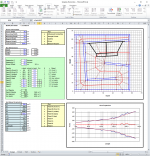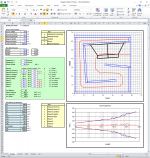Thanks Brian!
Gave it a go and it sure seems to be a very good tool for iteration purposes, I started of making all the internal panels 12mm and I took down the external from 17 to 15mm, adjusted the S1 to a little more comforting 250cm2, set the expansion to 3 & 12deg, driver offset to 20cm and eventually arrived at 171 external volume, 139 internal, oh and I did all this in Ubuntu (Linux) using libre office, worked like a charm 🙂
But this was not the intention of the thread, should you still be interested I have attached my try with the spreadsheet.
Big thanks for this Brian! excellent work!
Gave it a go and it sure seems to be a very good tool for iteration purposes, I started of making all the internal panels 12mm and I took down the external from 17 to 15mm, adjusted the S1 to a little more comforting 250cm2, set the expansion to 3 & 12deg, driver offset to 20cm and eventually arrived at 171 external volume, 139 internal, oh and I did all this in Ubuntu (Linux) using libre office, worked like a charm 🙂
But this was not the intention of the thread, should you still be interested I have attached my try with the spreadsheet.
Big thanks for this Brian! excellent work!
Attachments
Last edited:
My attempt above does not sim well, at all, don't even try it 🙂 should have seen that coming I guess 🙂 but at least now I can keep on iterating on this until I get something, thanks again Brian.
Comparison between original Tham15 and Tham15ds
I made a comparison with a driver that sims prety well in the Tham, The oberton 15xb700 (price around 185 euro) from lautsprechershop.de. A even cheaper alternatavie is the Oberton 15B500 for around 130 euro.
Brian THAM15ds (GREY)
THAM15 Original (BLACK)








Compared to the original tham Brians version slightly shifts the frequency range by about 5hz.
THAM15 original:
120,5db/40.4hz
128db/60hz
127,7db/80hz
129.2db/100hz
130,4db/125hz
THAM15DS:
119db/40hz
129db/60hz
128,2db/100hz
129,6db/125hz
IMHO the outcome is so close that if used in multiples with frequency ranges between 40-120hz. You probably never know which one was which.
However if you want to use the box for a wider range of frequencies you probably better of with the THAM15DS, it 'sims' pretty flat up to 158hz compared to the tham15 which has a large dip starting around 129,5hz.
It was fun to read the original thread with all the theory's to 'fix' things, especially the ones with the 'dog food' mods and tests. Knowing now what we didn't then I think we can asume that some cone correction on the original tham can compensate the dips in the higher frequency ranges.
Hopefully I start building both versions before the end of the year. Now going to test a THAM6 and other HTTH with a Tang Band w6-1139si driver.
I made a comparison with a driver that sims prety well in the Tham, The oberton 15xb700 (price around 185 euro) from lautsprechershop.de. A even cheaper alternatavie is the Oberton 15B500 for around 130 euro.
Brian THAM15ds (GREY)
THAM15 Original (BLACK)
Compared to the original tham Brians version slightly shifts the frequency range by about 5hz.
THAM15 original:
120,5db/40.4hz
128db/60hz
127,7db/80hz
129.2db/100hz
130,4db/125hz
THAM15DS:
119db/40hz
129db/60hz
128,2db/100hz
129,6db/125hz
IMHO the outcome is so close that if used in multiples with frequency ranges between 40-120hz. You probably never know which one was which.
However if you want to use the box for a wider range of frequencies you probably better of with the THAM15DS, it 'sims' pretty flat up to 158hz compared to the tham15 which has a large dip starting around 129,5hz.
It was fun to read the original thread with all the theory's to 'fix' things, especially the ones with the 'dog food' mods and tests. Knowing now what we didn't then I think we can asume that some cone correction on the original tham can compensate the dips in the higher frequency ranges.
Hopefully I start building both versions before the end of the year. Now going to test a THAM6 and other HTTH with a Tang Band w6-1139si driver.
Hopefully I start building both versions before the end of the year.
Have you made any progress on your builds? That sale price has me wanting to pull the trigger on one to play around with.
Last edited:
Dammit. Curiosity got the best of me. I just ordered one on PE for $149 with a coupon. I'll help build and pound on one. I might ask some questions in the near future. Thanks.
THANKS FOR POSTING! The PA385 sims well in most all things I've tried. I think it's a winner. Best of luck on your build.
Have you made any progress on your builds? That sale price has me wanting to pull the trigger on one to play around with.
Just started yesterday with building the Original design. Probably starting on the DS next week. Also looking at some cone compensation options (tests) once build.
Last edited:
Just started yesterday with building the Original design. Probably starting on the DS next week. Also looking at some cone compensation options (tests) once build.
Good to hear. My speaker has shipped so I will be joining the fun shortly. I am planning on going with one of Brian's spreadsheet designs from this thread. I will have to re-read this thread and come up with a game plan.
Best of luck!
UPS brought a present. I am planning on going wood shopping Friday.
An externally hosted image should be here but it was not working when we last tested it.
How does the Dayton sim in the THAM15?
I am not in front of a computer right now but I believe when I simmed the PA385 in the original tham15 the resultsing curve looked extremely close to the 15tbx100. Maybe someone else will confirm before I get home.
OK, I picked up a couple sheets of 3/4" baltic birch. They measured out at 18mm. Here is what I am planing on going forward with. (unless anyone sees any glaring mistakes)
An externally hosted image should be here but it was not working when we last tested it.
An externally hosted image should be here but it was not working when we last tested it.
An externally hosted image should be here but it was not working when we last tested it.
An externally hosted image should be here but it was not working when we last tested it.
Last edited:
OK, I picked up a couple sheets of 3/4" baltic birch. They measured out at 18mm. Here is what I am planing on going forward with. (unless anyone sees any glaring mistakes)
An externally hosted image should be here but it was not working when we last tested it.
The spreadsheet's expansion graph suggests that you've got a bit of an error after the first fold from the mouth, where that section is a bit too narrow. This may throw off the results a bit. If you increase the height of the TH slightly and lengthen the second internal panel a bit, that should reduce the error. The alternative is to set the external dimensions that you'd like to use and rejig the internal fold until all expansion errors are minimized as much as possible.
Thank Brian,The spreadsheet's expansion graph suggests that you've got a bit of an error after the first fold from the mouth, where that section is a bit too narrow. This may throw off the results a bit. If you increase the height of the TH slightly and lengthen the second internal panel a bit, that should reduce the error. The alternative is to set the external dimensions that you'd like to use and rejig the internal fold until all expansion errors are minimized as much as possible.
I made the cabinet a bit taller and adjusted the fold slightly. How does this look?


I made the cabinet a bit taller and adjusted the fold slightly. How does this look?
You've still got a bit of an error in that part of the expansion - now it's too large, LOL.
Here's a layout that minimizes the errors. You'll notice that I've adjusted a few entries in the spreadsheet to get this. In the Horn Expansion graph, the error line (read) is now almost completely flat (not counting the little bumps which signify where the bends are). This should be the solution to look for, unless you deliberately want to leave part of the horn larger or smaller than required for the sim.
However, have a look at the external box dimensions - 22.8" x 25.9" x 20". If I was starting with this, I'd adjust the dimensions to 23" x 26" x 20" (or maybe 22 x 27 x 20), then adjust the expansion curves and panel lengths for panels F, G, H and I to restore a smooth horn expansion.
Attachments
Thanks for the patience 🙂 I'll put the bottle down and go see if third time is a charm. I'll be back 🙂
On a whim, I've decided to update the spreadsheet to change the layout of the A,B, F and I panels a bit - basically changing how they're joined to each other to provide a smoother expansion at the horn's mouth. I've also changed it a bit to allow adjustments directly to panel A and panel B, rather than calculating from S1 and S2. I still have to go through the spreadsheet to check for errors, but the results look promising:
Attachments
Thanks Brian,
I input the panel dimensions in to optimalon.com cut sheet calculator and came up with the following. It looks like we can get this on one sheet with extra to spare for bracing. Unless I messed something up. 🙂

I think it is time to start making dust.
I input the panel dimensions in to optimalon.com cut sheet calculator and came up with the following. It looks like we can get this on one sheet with extra to spare for bracing. Unless I messed something up. 🙂

I think it is time to start making dust.
- Status
- Not open for further replies.
- Home
- Loudspeakers
- Subwoofers
- Help reverse engineering sim THAM15DS

